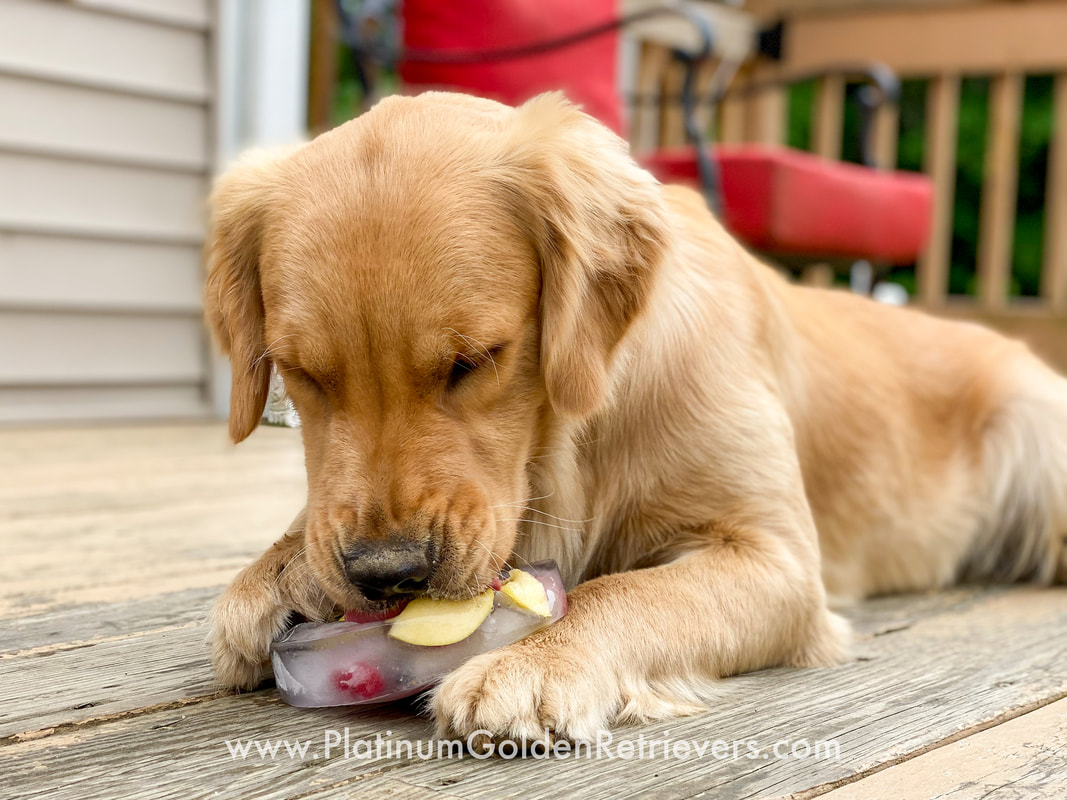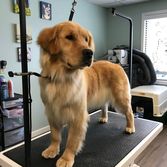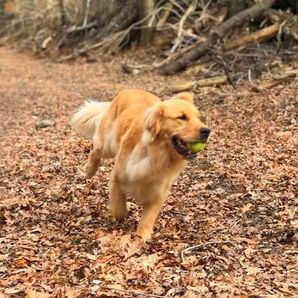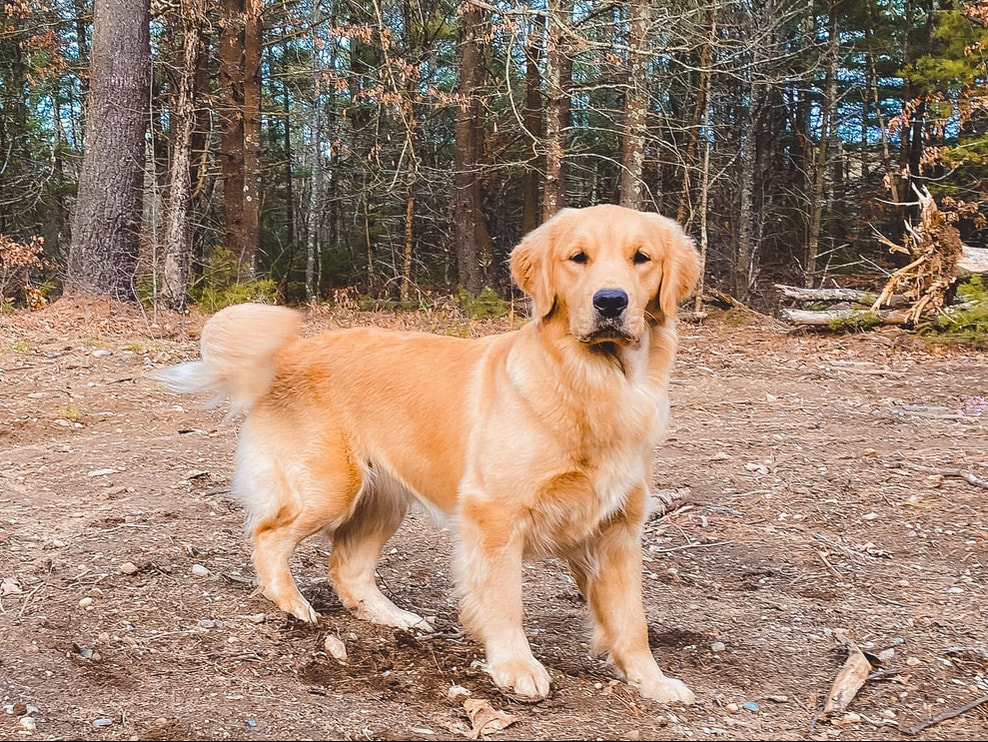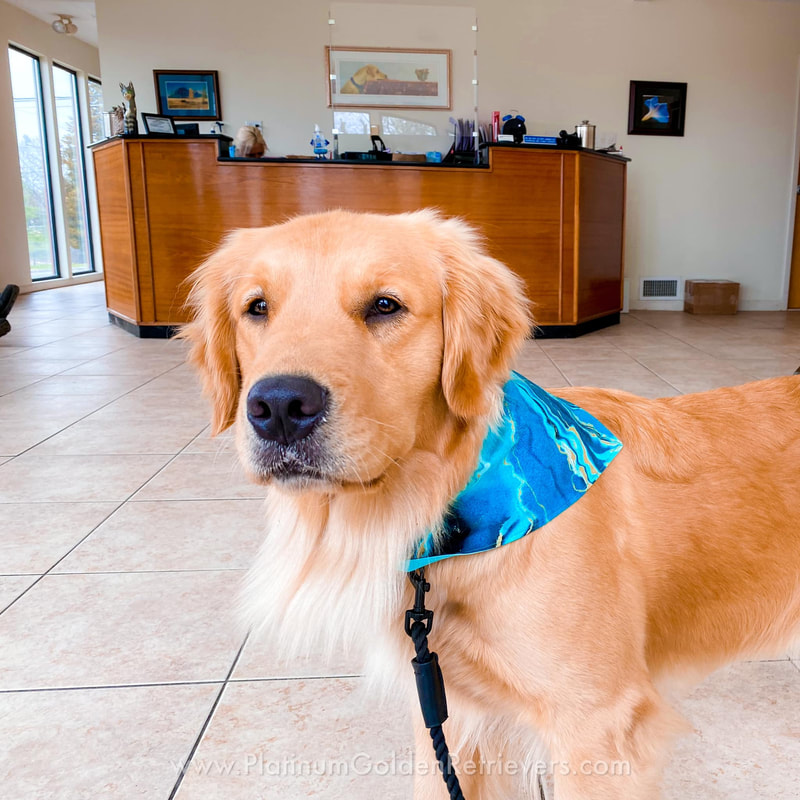THE HISTORY:
The Golden Retriever, with its intelligence and eager to please attitude, is one of the most popular breeds in the United States according to American Kennel Club registration statistics. The working ability that has made the Golden Retriever such a useful hunting companion also make them an ideal guide, assistance and search and rescue dog. The golden-colored coat is one hallmark of this versatile breed, and can range from light to dark gold.
The Golden Retriever originated in the Scottish Highlands in the late 1800's and was used predominantly for hunting. The breed was developed by Lord Tweedmouth, whose goal was to create a superb retriever suited to the Scottish climate, terrain and available game. He crossed his original "Yellow Retriever" with the Tweed Water Spaniel (now extinct) found on his estate. Later integrations of Irish Setter, Bloodhound, and more Tweed Water Spaniel produced the retriever we know today.
The temperament of the Golden Retriever is another hallmark of the breed and is described in the standard as "kind, friendly and confident". They are not "one man dogs" and are generally equally amiable with both strangers and those familiar to them. Their trusting, gentle disposition therefore makes them a poor guard dog. A Golden Retriever should not be unduly timid or nervous. The typical Golden Retriever is calm, naturally intelligent and biddable, with an exceptional eagerness to please. Golden Retrievers are also noted for their intelligence. The Golden Retriever ranks fourth in Stanley Coren's The Intelligence of Dogs, being one of the brightest dogs ranked by obedience command trainability. These dogs are also renowned for their patience with children.
The Golden Retriever originated in the Scottish Highlands in the late 1800's and was used predominantly for hunting. The breed was developed by Lord Tweedmouth, whose goal was to create a superb retriever suited to the Scottish climate, terrain and available game. He crossed his original "Yellow Retriever" with the Tweed Water Spaniel (now extinct) found on his estate. Later integrations of Irish Setter, Bloodhound, and more Tweed Water Spaniel produced the retriever we know today.
- Sporting Group: AKC recognized in 1925.
- Average size: from 55 to 75 pounds.
- Devoted companion & hunting dog.
The temperament of the Golden Retriever is another hallmark of the breed and is described in the standard as "kind, friendly and confident". They are not "one man dogs" and are generally equally amiable with both strangers and those familiar to them. Their trusting, gentle disposition therefore makes them a poor guard dog. A Golden Retriever should not be unduly timid or nervous. The typical Golden Retriever is calm, naturally intelligent and biddable, with an exceptional eagerness to please. Golden Retrievers are also noted for their intelligence. The Golden Retriever ranks fourth in Stanley Coren's The Intelligence of Dogs, being one of the brightest dogs ranked by obedience command trainability. These dogs are also renowned for their patience with children.
|
NUTRITION A high-quality dog food appropriate for the dog’s age (puppy, adult, or senior) will have all the nutrients the breed needs. Some Goldens can become overweight, so watch your dog’s calorie consumption and weight level. If you choose to give your dog treats, do so in moderation. Treats can be an important aid in training, but giving too many can cause obesity. Give table scraps sparingly, if at all, especially avoiding cooked bones and foods with high fat content. Learn about which human foods are safe for dogs, and which are not. Check with your vet if you have any concerns about your dog’s weight or diet. |
GROOMING Goldens heavily shed their thick, water-repellent double coat once or twice a year, and they also shed more moderately on a continuous basis. Most of the time, a good brushing-out with a slicker brush once or twice a week will remove much of the dead hair before it has a chance to fall onto the furniture. During times of heavy shedding, these brushing sessions turn into daily affairs. Baths help to loosen the dead hairs, but the dog must be completely dry before brushing begins. Otherwise, Goldens only need occasional baths to keep them clean. As with all breeds, the Golden’s nails should be trimmed regularly. |
EXERCISE Like most Sporting breeds, Goldens need plenty of daily exercise. A Golden who doesn’t get enough exercise is likely to engage in undesirable behavior. Goldens make great companions on long runs and bike rides, although consultation with a vet is recommended before starting strenuous or high-impact activities that might cause stress to the dog’s bones and joints. Many Goldens happily get their exercise on hunting trips or at field trials, as well as by participating in canine sports such as agility, obedience, and tracking. |
By the time they reach maturity however, Goldens will have become active and fun-loving animals with the exceptionally patient demeanor befitting a dog bred to sit quietly for hours in a hunting blind. Adult Golden Retrievers love to work and have a keen ability to focus on any given task. They will seemingly work until collapse, so care should be taken to avoid overworking them.
Other characteristics related to their hunting heritage are a size suited for scrambling in and out of boats and an inordinate love for water. Golden Retrievers are exceptionally trainable due to their intelligence, athleticism and desire to please their handlers—and generally excel in obedience trials. In fact, the first AKC Obedience Trial Champion was a Golden Retriever. They are also very competitive
in agility and other performance events. Harsh training methods are unnecessary as Golden Retrievers often respond very well to positive and upbeat training styles.
Golden Retrievers are compatible with children and adults and are good with other dogs, cats and most livestock. Golden Retrievers are particularly valued for their high level of sociability towards people, calmness, and willingness to learn. Because of this, they are commonly used as guide dogs, mobility assistance dogs, and search and rescue dogs. They are friendly and tend to learn commands easily.
They are also known to become excellent surrogate mothers to different species. Kittens and even tiger cubs from zoos are well taken care of by golden retrievers. In some cases, a retriever may produce milk for its adopted even though it may not have been pregnant or nursing recently.
Other characteristics related to their hunting heritage are a size suited for scrambling in and out of boats and an inordinate love for water. Golden Retrievers are exceptionally trainable due to their intelligence, athleticism and desire to please their handlers—and generally excel in obedience trials. In fact, the first AKC Obedience Trial Champion was a Golden Retriever. They are also very competitive
in agility and other performance events. Harsh training methods are unnecessary as Golden Retrievers often respond very well to positive and upbeat training styles.
Golden Retrievers are compatible with children and adults and are good with other dogs, cats and most livestock. Golden Retrievers are particularly valued for their high level of sociability towards people, calmness, and willingness to learn. Because of this, they are commonly used as guide dogs, mobility assistance dogs, and search and rescue dogs. They are friendly and tend to learn commands easily.
They are also known to become excellent surrogate mothers to different species. Kittens and even tiger cubs from zoos are well taken care of by golden retrievers. In some cases, a retriever may produce milk for its adopted even though it may not have been pregnant or nursing recently.
|
APPEARENCE A symmetrical, powerful, active dog, sound and well put together, not clumsy nor long in the leg, displaying a kindly expression and possessing a personality that is eager, alert and self-confident. Primarily a hunting dog, he should be shown in hard working condition. Overall appearance, balance, gait and purpose to be given more emphasis than any of his component parts. Faults-Any departure from the described ideal shall be considered faulty to the degree to which it interferes with the breed’s purpose or is contrary to breed character. |
TRAINING As with all breeds, early socialization and puppy training classes are recommended. Gently exposing the puppy to a wide variety of people, places, and situations between the ages of seven weeks and four months will help the Golden develop into a well-adjusted, well-mannered adult. Puppy training classes serve as part of the socialization process and help the owner learn to recognize and correct any bad habits that may be developing. Obedience training strengthens the bond between dog and owner—a Golden wants nothing more than to please his human. Golden Retrievers are outgoing, loyal, and eager to do your bidding, which makes them very easy to train. |
HEALTH Goldens are generally healthy dogs, and responsible breeders will screen their breeding stock for health conditions including elbow and hip dysplasia; eye conditions such as juvenile cataracts, pigmentary uveitis, and progressive retinal atrophy; and certain heart diseases, including subvalvular aortic stenosis. The Golden’s ears should be checked weekly for signs of infection, and the teeth should be brushed often. Recommended Health Tests from the National Breed Club:
|


